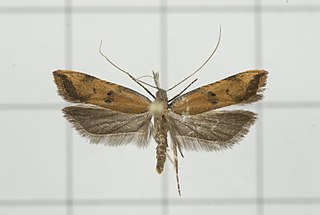Dichomeris albula is a moth of the family Gelechiidae. It was described by Kyu-Tek Park and Ronald W. Hodges in 1995. It is indigenous to Taiwan.

Dichomeris angulata is a moth of the family Gelechiidae. It was described by Kyu-Tek Park and Ronald W. Hodges in 1995. It is known from Taiwan.
Dichomeris aculata is a moth in the family Gelechiidae. It was described by Kyu-Tek Park in 2001. It is found in Taiwan.
Dichomeris fareasta is a moth in the family Gelechiidae. It was described by Kyu-Tek Park in 1994. It is found in south-eastern Siberia and Korea.
Dichomeris polypunctata is a moth in the family Gelechiidae. It was described by Kyu-Tek Park in 1994. It is found in south-eastern Siberia, Korea and Mongolia.
Dichomeris mitteri is a moth in the family Gelechiidae. It was described by Kyu-Tek Park in 1994. It is found in China (Shaanxi), Korea and Japan.
Dichomeris minutia is a moth in the family Gelechiidae. It was described by Kyu-Tek Park in 1994. It is found in Korea.
Dichomeris moriutii is a moth in the family Gelechiidae. It was described by Ponomarenko and Ueda in 2004. It is found in China and Thailand.
Dichomeris cymatodes is a moth in the family Gelechiidae. It was described by Edward Meyrick in 1916. It is found in the Indian state of Assam, Hong Kong, Guizhou and Hunan in China and in Taiwan.
Dichomeris davisi is a moth in the family Gelechiidae. It was described by Kyu-Tek Park and Ronald W. Hodges in 1995. It is found in Sri Lanka, China and Taiwan.

Dichomeris fuscalis is a moth in the family Gelechiidae. It was described by Kyu-Tek Park and Ronald W. Hodges in 1995. It is found in China and Taiwan.
Dichomeris orientis is a moth in the family Gelechiidae. It was described by Kyu-Tek Park and Ronald W. Hodges in 1995. It is found in China and Taiwan.
Dichomeris fusca is a moth in the family Gelechiidae. It was described by Kyu-Tek Park and Ronald W. Hodges in 1995. It is found in Taiwan.
Dichomeris lutea is a moth in the family Gelechiidae. It was described by Park Kyu-Tek and Ronald W. Hodges in 1995. It is found in Taiwan.
Dichomeris crambaleas is a moth in the family Gelechiidae. It was described by Edward Meyrick in 1913. It is found in Taiwan and Assam, India.
Dichomeris ochreata is a moth in the family Gelechiidae. It was described by Kyu-Tek Park and Ronald W. Hodges in 1995. It is found in Taiwan.

Dichomeris trilobella is a moth in the family Gelechiidae. It was described by Kyu-Tek Park and Ronald W. Hodges in 1995. It is found in Taiwan.
Dichomeris taiwana is a moth in the family Gelechiidae. It was described by Kyu-Tek Park and Ronald W. Hodges in 1995. It is found in Taiwan.
Dichomeris lividula is a moth in the family Gelechiidae. It was described by Kyu-Tek Park and Ronald W. Hodges in 1995. It is found in Taiwan.
Dichomeris bulawskii is a moth in the family Gelechiidae. It was described by Ponomarenko and Park in 1996. It is found in south-eastern Siberia.


